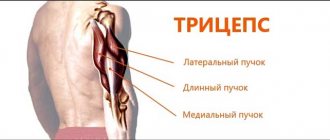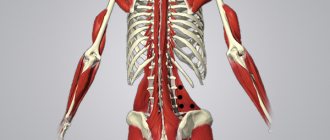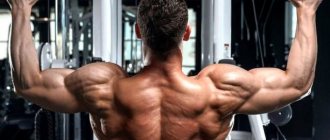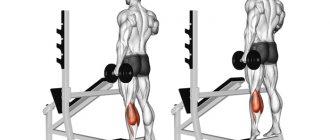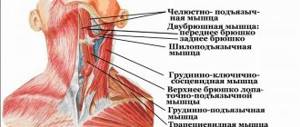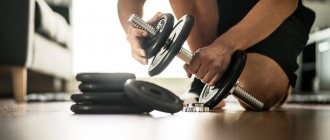Adjustable bench
This device will help you train comfortably, change the angles of loads (this is very important for the pectoral muscles) + you can train many other muscle groups (the same abs, all kinds of presses, push-ups on a bench, doing dumbbell rows with an emphasis on the bench) in Overall, I recommend this device...
That's all, friends.
All you need is:
- collapsible dumbbells (weighing from 10 to 40 kg)
- parallel bars (ideally a wall bars with a horizontal bar)
- adjustable bench
The most important thing is, of course, collapsible dumbbells. Because We don’t have the opportunity to purchase an Olympic bar and weights for it, for many reasons (no money, no space, or some other reason) we need an alternative and these are dumbbells!
Nutrition for muscle growth
For high-quality growth, you need 4 grams of carbohydrates per kilogram of weight, 3 grams of protein and 2 grams of fat. A deficiency of not only proteins (building material), but also carbohydrates (fuel for muscles) will not allow you to increase in volume.
Example menu
- Breakfast: Oatmeal with honey or dried fruits, cottage cheese;
- Snack: toast with low-fat cheese;
- Lunch: rice or buckwheat porridge, baked chicken fillet;
- Afternoon snack: boiled eggs, cottage cheese, fruit;
- Dinner: Meat or fish with vegetables;
- Late dinner: fermented milk products.
Examples of programs for training chest muscles
Before I describe the complex to you, I’ll tell you about the basic rules that I took into account when writing programs:
- The order of the exercises is as follows: we start with the more complex (heavy) and end with the simpler (lighter). See below what should be the first exercise.
- The first exercise for training at home will be one of two possible: dumbbell bench presses or parallel bars.
- If you don't have parallel bars and have heavy dumbbells, start with dumbbell bench presses.
- If you don't have heavy dumbbells, start your workout with parallel bars.
- Perform about 4-6 working sets of 6-12 repetitions. But before working, do not forget to do warm-ups with light weights for 10-20 repetitions.
- Select weights (dumbbell weights) so that muscle failure occurs within 6-12 repetitions. If you were able to do more than 12 times, the weight is small for you, you should increase the weight of the dumbbells (otherwise there will be no growth).
Training programs
- Dumbbell bench press 4-6x6-12 reps
- Dips 4-6x6-12 reps
- Lying dumbbell fly 4x6-12 reps
Either way
- Dips 4-6x6-12 reps
- Dumbbell bench press 4-6x6-12 reps
- Lying dumbbell fly 4x6-12 reps
Either way
- Dips 6x6-12
- Dumbbell bench press 8x6-12
Either way
- Dumbbell bench press 6x6-12
- Push-ups from the floor (with additional weights) 5-6x6-15
- Lying dumbbell fly 4-6x6-12
This is a very important parameter that I must explain to you - the technique of performing the exercises.
Those. For a full training of the pectoral muscles, it is vitally important to follow the correct technique, otherwise there can be no talk of any growth of the pectoral muscles.
Let me explain! You can do push-ups (but with an emphasis not on the chest, but on the triceps); accordingly, your arms grow, but your chest does not. The same goes for dumbbell bench presses. Technology is extremely important...
How to pump up your pectoral muscles
Let's try to figure out how to pump up the pectoral muscles so that the end result pleases both you and those around you. To begin with, let’s conditionally divide the chest into four components:
middle part
inner part
Bottom part
top part
Let's consider exercises that allow you to load one or another part of the chest muscles.
How to pump up the middle part of the pectoral muscles
the classic bench press right away . This is the main basic exercise for working the middle part of the pectoral muscles. Lower the barbell towards your chest, and to maintain tension, try not to fully straighten your arms in the upper position.
Experienced athletes also highlight the outer part of the chest. The following is important; The wider the grip you use on your presses, the more the outer chest muscles are loaded.
Next, let's look at dumbbell raises in a lying position . This exercise targets the outer area of the pectoral muscles directly. You need to raise the dumbbells as low as possible, but only without the risk of injury.
This exercise perfectly stretches the pectoral muscles. When performing it, we can use the largest amplitude. In the maximum diluted state, both the middle and outer parts of the chest muscles will be worked out.
Read also: Training the upper pectoral muscles
How to pump up the inner pectoral muscles
Particularly good exercises for the inner part of the chest muscles are abbreviation or block crossovers . At the point when the arms are completely brought together, the load is maximum and the inner part of the pectoral muscles is fully activated.
In addition, you can use barbell bench presses and dumbbell flyes to give the inner area a good workout.
When doing flyes, try to make the dumbbells touch each other at the highest position and tighten your pectoral muscles for 2-3 seconds. When doing presses, you just need to use a narrow grip (either shoulder-width apart or slightly smaller)
How to pump up the lower part of the pectoral muscles
Now let's talk about pumping the lower parts of the pectoral muscles. The reverse inclination of the bench is responsible for this muscle group. When bench pressing a barbell, performed on a horizontal bench, this is primarily the middle lobe of the chest and a little of its lower part. For a more in-depth study of the lower chest, you need to perform a bench press on a bench with a reverse inclination angle.
However, we must remember that head presses are a very harmful exercise, since when they are performed, the athlete’s blood pressure increases. Based on this, the best exercise for pumping up the lower chest is considered to be the dip . It perfectly pumps and trims the chest.
How to pump up your upper pectoral muscles
To pump up the upper chest, exercises such as dumbbell or barbell presses on an incline bench are perfect. When the angle of the bench begins to rise, the load gradually moves upward. The optimal angle of the bench for working the upper chest muscles can be considered 30-45 degrees.
It is important to remember that the higher the angle of inclination, the more actively the deltoids are involved in the work, and the lower the angle of inclination, the greater the load goes into the triceps. You must take this into account and find the optimal angle of inclination for yourself.
Dips
This is a heavy compound exercise that will help your pectoral muscles grow.
Subject to the correct execution technique and progression of loads.
You will need to constantly increase the load (increase the weights or repetitions), for example, you did 12 times with your own weight, add weight on yourself +1 kg, did 8 times, the next workout again with the same +1 kilograms, do 10 or 11 (as many as you get) as soon as reach 12 repetitions, INCREASE THE WEIGHT (BUT NOT MUCH by 1.25 or 2.25 kg NO MORE). In a month it will already be 10 kg, in 2 - 15. This is the progression of the load. Okay, I’ve moved away, let’s look at the equipment.
In order to include only the chest in the work and at the same time completely turn off the triceps, you need to spread your arms as wide as possible when doing push-ups, the next thing you need to do is not to straighten your arms all the way at the top point (i.e. go down and rise up but not all the way, DO NOT BEND YOUR ARMS). Only with this execution will the load be maintained in the chest. The next thing you need to do is tilt your body forward. Those. remember, the more you tilt your body forward, the more your pecs will work; the more you tilt your body back, the more your triceps will work.
Conclusion: Weigh on the uneven bars, arms as wide as possible, bend forward as much as possible, start doing push-ups and do not straighten your arms at the top point, and so on for 12 repetitions. Breathing: exhale with effort, that is, when you reach the top point, exhale (exhale air).
Iron Health
Despite the stupidity and absurdity of this question, it is quite possible to create a competent training program and plan a sports regime for it. Of course, all experienced athletes will say that it is simply impossible to pump up the pectoral muscles in a month, and, in fact, they will be right. However, the higher goals you set for yourself, the greater results you will achieve. This is a truism that can help us.
The main goal tool is specialization
In our case, setting a goal to pump up the pectoral muscles in a month, we need to choose the optimal training regimen and write a training program. As for the training regimen, the optimal solution here would be specialized training of the pectoral muscles 2 times a week. The first is heavy, high-intensity, the second is light, high-volume. At the same time, these two workouts are placed at the ends of the week (Monday and Friday), which allows us to pump our chest quite often without fear of overtraining. All that remains is to write programs for these two days.
Program for pumping up the pectoral muscles in a month
#Monday – hard chest workout
| Exercises | Approaches | Repetitions | Rest between sets |
| Bench press | 3 | 6 | 3 min |
| Dumbbell Bench Press | 3 | 8 | 3 min |
| Information in the “Butterfly” simulator | 3 | 10 | 2.5 min |
#Friday - easy chest workout
| Exercises | Approaches | Repetitions | Rest between sets |
| Parallel push-ups (with the body tilted forward) | 3 | 12 | 3 min |
| Bent-over barbell press (head up) | 3 | 12 | 3 min |
| Crossovers on the upper blocks | 3 | 12 | 2.5 min |
| Lying dumbbell flyes | 3 | 15 | 2 minutes |
Program execution method
- The total duration of the program is 6 weeks.
- Accurately select the working weight for the required number of repetitions, especially on the day of heavy chest training (see article - “Correct calculation of working weight”).
- Try to maintain perfect technique, especially in those exercises that should be performed in a large number of repetitions (10 and above).
- Don't skip workouts - skipping sessions reduces the effectiveness of this training program to a minimum.
- Eat enough protein - make sure each meal contains 30 grams of protein (see article - How much protein is in different foods?).
- After your workout, be sure to take whey protein and creatine (in recommended dosages).
- Days of training the pectoral muscles can be easily combined with training the biceps and back muscles. Combination with training of other muscle groups is ineffective.
What results can I expect from the program?
With strict adherence to the program implementation methodology and sports regimen, you will significantly increase the strength and mass of the pectoral muscles. Your further training plan will depend on your goals. However, after completing this complex, I advise you to work on increasing the working weights (see the article - “Training program for the strength of the pectoral muscles”), this will allow you to significantly increase the strength potential of the pectoral muscles and make subsequent weight training more effective.
Push-ups on stools
As mentioned above, push-ups, despite all their effectiveness, are still not a good enough exercise for the full development of the pectoral muscles.
To complicate the exercise, you can take two stools and place them the width of your arms outstretched to the side, with your elbows bent.
After this, we take the usual position for push-ups, but put our hands on stools. Feet must be placed on a sofa or chair. You need to do four sets of 10-20 push-ups.
During each push-up, try to get as low as possible from the level of the stools. If you feel that you can cope with this without problems, then do not rush to immediately increase the number of push-ups. For greater effect, it is better to start doing push-ups with a load. We perform 4 sets of 10-20 repetitions. Take a break of 2-3 minutes between each set, or more if necessary.
Super selection of diets and workouts
How to remove lower belly fat quickly and effectively
How Kartunkova lost weight. Diet Kartunkova
Malysheva’s diet: menu for every day, recipes
How to lose weight by jumping rope. Weight loss table
The series of materials on pumping up the chest muscles and a review of the most common and effective exercises for them is gradually coming to an end. There’s only one small thing left to do, namely, talk about isolation exercises.
The common and common name for them is wiring, but, if we are to be very precise, it is a combination of hands .
Isolation exercises for the chest, in essence, are no different from other isolation exercises (for example, for legs or arms). The meaning of such exercises is that one joint one muscle works (or a muscle group, if it cannot be divided during training).
In the case of the pectoral muscles, this is achieved under two conditions: only the shoulder joint works, and the exercise is aimed at bringing the arms together in front of you (with weights, of course). We will talk about only three exercises that satisfy these requirements.
Before I outline these three exercises, according to tradition, I will tell you a few features that it is advisable to always keep in mind and not forget. I do this so that I don’t have to talk about them in every exercise, and you don’t read the same thing several times.
- In each pinch of the arms to work the pectoral muscles, the elbows are slightly bent and motionless . This is how we protect our elbows from possible injuries - we avoid the arm position that is vulnerable to bending (straight).
- Exercises are performed slowly (compared to basic ones) and consciously, in order to avoid injuries. After all, only one joint works (the shoulder) and it bears a large load.
- At the point of peak tension there is a pause of about half a second. We do this so that the chest muscles further contract under maximum load.
- At the point of maximum stretching, we continue the movement until severe pain . The fact that it will hurt is normal, the muscles are stretched, but as soon as the pain becomes “uncomfortable”, this is a signal that you can’t pull any further. Unfortunately, in this aspect there are no other techniques - only personal feelings.
HANDS WITH DUMBBELLS LYING UP
The most accessible (does not require expensive training equipment) exercise. The technique is almost identical to the dumbbell press, the only difference is in the fixation of the elbows and the movement of the arms. Everything else is discussed in detail in the bench press, so here we will only go over the differences.
Performance
- We sit down, put the dumbbells on our knees and lift them up with our legs, while lying down on the surface of the bench.
- We move our arms to the sides from the body and down, the dumbbell bars are parallel to each other.
- We bring our hands in front of us, leaning the dumbbells at the top, towards each other. Exhale with effort.
That's all the execution. Of course, it is worth removing the arch in the lower back by lifting your legs. Also, no one has canceled the various inclinations of the surface on which you lie.
Everything is as always: head up (30-45 degrees) - the most balanced option and works the top of the chest; horizontally – middle and bottom of the chest + maximum weight; head down - lower chest and triceps, as well as a rush of blood to the head (bad option).
The last thing about dumbbell raises is the possibility of supination and pronation, which I have talked about more than once (if anyone doesn’t know, find out from the dumbbell press). But, I think adding rotational movement to flyes is a bad complication of the exercise. I'll explain why.
In isolation exercises, it is very important not to involve more than one joint and try to focus the work on one muscle. In this case, these are paired joints and muscles - shoulders and chest. So, when rotating your hands, you engage the muscles of the forearms, as well as the wrist joint.
Yes, many (including professionals) may disagree that this will negatively affect your training. But I am inclined to think that it is more logical to add rotations to the base , where several joints are already working and a lot of weight is used.
Namely, in isolating the chest muscles, with a “super-precise” technique, these rotations will do more harm than good - starting with the fact that you will have to think about the position of the hands (and their symmetry) and ending with some of the blood leaving the forearms. It's up to you, friends, I voiced my opinion.
BRINGING HANDS IN A CROSSOVER
A more complex isolating exercise, which, thanks to the standing position and impressive appearance in the mirror, will appeal to many. And after benching barbells and dumbbells, I want to change the situation a little.
Performance
- We select and set the handles to the desired height.
- We stand, taking the handles in our hands, choosing a comfortable position. Here you need to try walking back and forth half a step to choose the best ratio of your body to the racks.
- Bend your knees a little and tilt your body a little forward. At the same time, keep your back straight.
- Looking forward (most likely in the mirror), we bring our hands together in front of us. We pause and return to the starting position.
- At the starting point, do not throw your arms too back, hold the weight, maintain the load.
Now comes the fun part . We can adjust the position of the handles vertically. With the help of such manipulations, it becomes possible to place an accentuated load on the upper, middle, and lower sections of the pectoralis major muscle.
Here are three options for maximum emphasis on each part of the pectoral muscles.
- The handles are at the bottom. The vector of movements from bottom to top will force the upper sections of our pectorals to work.
- Handles in the middle - the middle of the pectoral muscle works.
- The handles are pointed up. In this case, the movements of the hands, when mixing, will be directed from top to bottom. The lower chest receives the load.
And a little advice : at the end of the negative movement (when the arms are apart), do not release the weight completely, work within the amplitude. With this simple technique, you will maintain the load in your muscles throughout the entire approach.
The only disadvantage of using a crossover is that you have to watch your tilt and coordination, as well as your hand movements. It's a little distracting, it's a little inconvenient.
Now about the advantages . Compared to the dumbbell version, we not only get the same ability to adjust the emphasis of the load, but also maintain muscle tension at the end point of the movement. This becomes possible thanks to the constant tension of the cables of the machine, and when we bring our hands together in front of us, the weight of the weight does not disappear anywhere (unlike recumbent dumbbell flyes, in which the weight at the top point simply “lies” on our hands).
In terms of efficiency and capabilities, the crossover is the best option for working the pectoral muscles.
ARM CRACKING IN THE EXERCISER (PECK-DECK / BUTTERFLY / ETC.)
Perhaps the most convenient isolating exercise that loads our chest.
In the case of using a peck-deck type simulator and similar “brothers” in design, we have a simple but important opportunity. And it comes down to the fact that we are not obliged to monitor the position of the body and the axes of movement.
Everything is simple here: we sit and our hands move horizontally fixed handles. And this is very good for two reasons. The first of them is ease of implementation, which beginners will like. And the second reason is that you don’t have to be distracted and don’t worry about the correctness of the technique - in this case it’s difficult to do it incorrectly, we just bring our hands together in front of us.
Performance
- We set the seat to the desired level.
- We sit down, pressed tightly against the back, keeping our body straight , the back of our head also pressed.
- We take the handles and rest our hands on the soft inserts (if there are any in a particular simulator).
- We bring our hands together in front of us, exhale and hold for half a second for maximum tension.
- We slightly relax the chest muscles, allowing the load to spread the arms to the sides, but not completely. Returning to the original position, we maintain tension in the muscles.
The main advantage of using such simulators is the ability to use the largest weights , in comparison with dumbbells or a crossover. It is the ease of execution and the virtual absence of the risk of incorrect technique that contribute to the fact that the weight of the load can be very large.
Well, about the disadvantage of this exercise. This is the impossibility of accentuated loading of different parts of the pectoral muscle, that is, the axis of movement is always the same, and the most work is done by the middle of the chest.
We looked at the basic and most popular isolation exercises for the chest muscles. I hope that each of them will bring you variety in your training and give you the desired relief to your chest.
It is important to remember the differences between these exercises and apply them appropriately, because each of them has its own disadvantages and advantages. I advise you to start with a peck-deck, then include dumbbell flyes, and finally, when you have confidence and desire, move on to a crossover.
Phil


